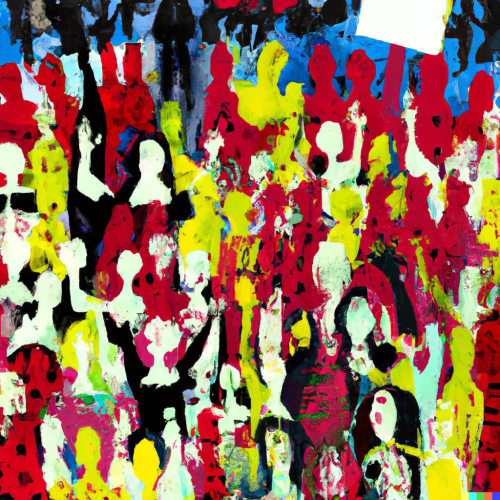The introduction of photo identification requirements for local and national elections in the United Kingdom sparked controversy within parliament until the results of the local elections on the 4th of May. Whilst it had been a topic for debate by experts and politicians, particularly on who the laws would impact the most, I found that there was little news coverage for public opinion on the new electoral law.
It was important to focus on the different age demographics for this news piece, as the views of my interviewees will often reflect their age group and how they vote. In essence, I was attempting to capture the views of each age demographic in order to understand and broadcast how the Electoral Act 2022 impacted the general public, now with the hindsight of the 2023 local elections.

Whilst the story was broadly targeted towards UK citizens eligible to vote, the target was primarily those who were unaware of how much the Electoral Act 2022 impacted the UK elections. I interviewed Dr Felicity Rice as an expert on the topic in order to ground my own understanding, then expanded out to members of the general public, helping to reflect on how my original attitude to electoral law had changed with my exploration of public opinion (Hogarth, 2019). With the next general election and dissolution of the current government in just over a year, it is important to notify the public of the impacts of voter ID requirements, and how it can change the results of the next national election by using the local elections as a case study.
Creating a short form video for this story helped to advertise the issue of voter ID by raising awareness on a social media platform. For example, Instagram (which is where the story was be published) allows the story to reach new audiences who are based primarily online, and may not know about the ongoing debate that is discussed in contemporary paper news (Gitner, 2016). As I intended on bringing a national topic of debate to a local audience, by using relatable footage of the Bournemouth area, such as Bournemouth pier and the pavilion, I was able to make the story relatable to my target local audience. Filming some of the different participants throughout several different age groups in the short form video also added accessibility to a larger target audience. Filming with a smartphone outside with interviewees allowed me to get out into the community and get closer access to my audience (Burum, Quinn, 2016).
The use of visual AI, particularly in the feature article, helped to artistically capture the role of democracy, and helped to draw a reader towards the main topic of the article before moving to the main text. One example of using art that reflected the article was creating a piece with lots of multicoloured silhouettes in order to promote democracy and diversity. The use of AI in the article has shown how AI is a powerful tool that can make a positive impact on our lives (Rossi, 2018/2019).
By reporting on the local elections after the results had been announced, the project managed to successfully avoid the many legal obstacles that are present when reporting on ongoing elections. However, caution was taken when considering which professional sources (i.e., running politicians) to contact, and it was decided that legally the safest interviewees would be those who won the election. In comparison to winning candidates whose success in the polls is impacted by their actions, making a comment on a candidate who lost due to electoral law could be damaging to the candidate’s chances in the next election if they choose to run again (Quinn, 2018).
Ethically, transparency on the context to the project with the general public was essential. It was important that members of the public felt that they did not need to disclose their voting preference, as this would not be necessary to accomplish the objective of the story. Journalists should explain their ethical choices, particularly how this would impact the interviewees (Plaisance, 2020). Therefore, I explained the background to the story to each interviewee, as well as the reason they were chosen for an interview before I started recording.
Both the feature article and the shortform video aim to provide context of new electoral laws after they impacted the 2023 local elections. For this story, it was best to avoid political analysis, and even political positions in the personal lives of interviewees (Carrol, 2020). Instead, this project aimed to analyse the consequences of voter identification laws by looking at multiple different demographics to understand how each group of voters was impacted.
Bibliography
Note that some images, including the cover image, were generated with the help of artificial intelligence programs DALL-E 2 and Nightcafe. Inputs relating to the theme of this story were submitted to create visual representations of the story that would not have been possible with camera photography.
Burum, I. Quinn, S. (2016) MOJO: the mobile journalism handbook: how to make broadcast videos with an iPhone or iPad. New York: Focal Press, Taylor and Francis Group.
Carroll, B. (2020) Writing and editing for digital media. Fourth edition. London: Routledge.
Gitner, S. (2016) Multimedia storytelling for digital communicators in a multiplatform world. New York: Routledge, Taylor and Francis Group.
Hogarth, M. (2019) Writing feature articles: print, digital and online. Fifth edition. London: Routledge, Taylor and Francis Group.
Plaisance, P. (2020) Media Ethics: Key Principles for Responsible Practice : Key Principles for Responsible Practice. San Diego, CA, United States: Cognella Academic Publishing.
Quinn, F. (2018) Law for Journalists: a guide to media law. Sixth edition. Harlow, United Kingdom; New York: Pearson.
Rossi, F. (2018/2019) “BUILDING TRUST IN ARTIFICIAL INTELLIGENCE,” Journal of International Affairs, 72 (1), pp.127-134. Accessed 28th May 2023.




